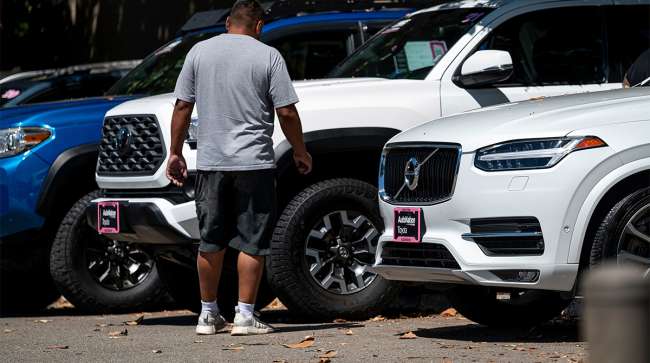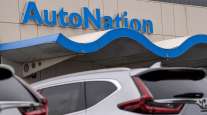Auto Sales Likely to Pick Up as Rates Fall

[Stay on top of transportation news: Get TTNews in your inbox.]
Sluggish car sales are expected to pick up later this year once the U.S. presidential election is over and the Fed’s recent reversal on interest rates starts to ease financing costs.
Many car shoppers stayed on the sidelines in the most recent quarter, even with more discounts being offered and improved selection in showrooms. Americans bought an estimated 3.9 million cars and trucks in the third quarter, a 2.3% drop from a year earlier and off 4.7% from the second quarter, according to automotive research firm Edmunds.com Inc.
One-third of car buyers said they are holding off on a new vehicle purchase until after the polls close on Nov. 5, based on the results of an August consumer survey by Edmunds.
Industry analysts attribute that to a more prevalent wait-and-see attitude about lower rates and the outcome of the race between Vice President Kamala Harris and former President Donald Trump, which could impact tax rates and subsidies for electric vehicles.
Today is the last day of Q3. Our team is expecting new-vehicle sales ytd to be up less than 1% compared to 2023. Our full year forecast of 15.7m remains unchanged. https://t.co/up7ZTyzWy6 — Cox Automotive (@CoxAutomotive) September 30, 2024
“Consumers don’t yet feel good about the future and confident that now is a good time to spend on big-ticket items,” Jonathan Smoke, chief economist at research firm Cox Automotive, said on a Sept. 25 call with reporters. “But that’s within reach for the first time in a long time.”
The Federal Reserve Bank’s half percentage point reduction in benchmark federal funds on Sept. 18 — and possible additional half-point cut by year’s end — will take some time to translate into lower car loan rates, which average 7.1% on new cars and 11.3% on used cars.
But the pace of sales is expected to pick up by year’s end, as auto loan rates recede and the next occupant of the White House is determined. Americans will buy 15.7 million cars and trucks this year, up 1.3% from last year’s 15.5 million, Cox has projected.
That will help keep vehicles rolling off dealer lots and out of factories, especially high-demand models such as gas-electric hybrids and midsized SUVs and trucks.
Just as hope begins to build for a recovery in sales, a new complication is emerging from the historic strike snarling operations at ports along the U.S. East Coast. Dockworkers walked off the job this week at 36 ports — a major threat to the economy that JPMorgan Chase & Co. estimates could cost $3.8 billion to $4.5 billion a day.

Hochul
New York Gov. Kathy Hochul on Sept. 30 warned of significant disruptions for consumers, particularly car shoppers, with the strike leading to an immediate halt in auto shipments.
“If you’re expecting to be able to get a new car this week, it may be something you want to check with your dealer,” Hochul said. “It may not be arriving, for example, in the next few weeks.”
General Motors Co., Stellantis NV, Toyota Motor Corp. and other carmakers plan to report U.S. sales results for the just-ended quarter on Oct. 1. Ford Motor Co. and Tesla Inc. are expected to release their latest numbers on Oct. 2.
At an average selling price of $47,870, up almost 20% since early 2020, Cox said many consumers still find new cars too pricey. That’s despite growing showroom inventory and a softening of manufacturer’s suggested retail prices, with average Monroney stickers down 1.7% from a year ago.
Monthly payments on car loans still average $767, up 17% from four years ago, according to Cox.
“Hyperinflation has made these cars really, really expensive,” Rhett Ricart, a Columbus, Ohio, auto dealer of Ford, GM, Hyundai and other auto brands, said in an interview. “And by increasing the technology content and the safety content on these vehicles, we packed on a lot of expenses.”
The closely watched annual sales rate fell to 15.6 million cars in the quarter ended Sept. 30, Cox estimated, down slightly from year earlier and well off the pre-pandemic pace of 17 million vehicles sold a year.
“New- vehicle sales remain stuck in neutral,” said Chris Hopson, principal analyst at researcher S&P Global Mobility. “Consumers in the market continue to be pressured by high interest rates and slow-to-recede vehicle prices, which are translating into high monthly payments.”
Want more news? Listen to today's daily briefing above or go here for more info
For the month of September, however, vehicle sales rose slightly to an annualized rate of 15.88 million, based on the consensus of five market researchers, up from a 15.8 million pace a year earlier.
While incentive spending on discounts has risen, auto manufacturers have kept that in check by showing restraint on production. So car buyers aren’t being offered the blowout deals they once enjoyed when sales softened.
“Automakers aren’t under as much pressure to move the metal at any cost,” said Jessica Caldwell, head of insights for Edmunds. “No one has started an incentives war in which other automakers feel obligated to join in to protect their market share.”




